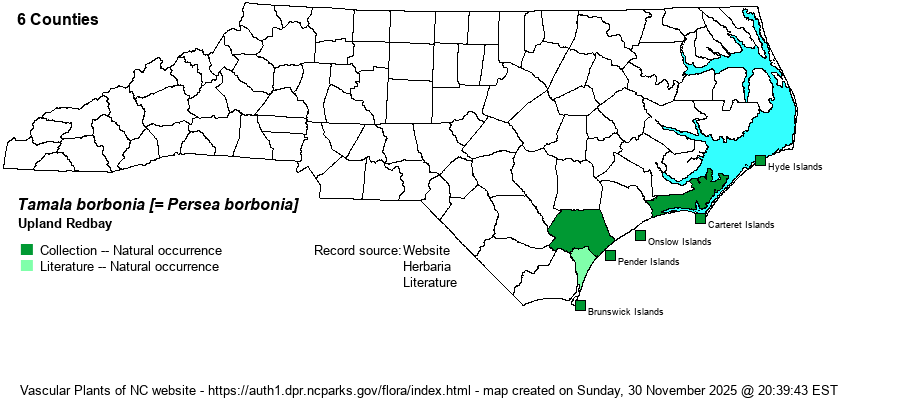| Author | (Linnaeus) Rafinesque | |
| Distribution | Coastal counties only, ranging from Hyde (LeBlond report from Ocracoke Island) to Brunswick, and possibly inland to Columbus County. Though the BONAP map and the NC NHP database contain records north to Currituck County and inland to Washington and Lenoir counties, Weakley (2018) says it ranges legitimately north only to Carteret County, with reports north of NC apparently in error, based on "less hairy plants of Tamala palustris". At any rate, there are quite a few additional counties listed for it in the SERNEC collections and the NC NHP database, but which are of questionable identification. In NC it occurs primarily on barrier islands.
This is a Southern species, ranging north only to coastal NC, and south to southern FL. It ranges west to central TX.
| |
| Abundance | Generally uncommon within a mile of the coast, and rare farther inland. This is an NC Watch List species. | |
| Habitat | This is an upland species growing on sandy soil on barrier islands and near the coast. It can occur on sandy ridges, drier portions of maritime forests, and low dunes. | |
| Phenology | Blooms in May and June, and fruits in September and October. | |
| Identification | This is a somewhat small evergreen tree, growing to about 30-35 feet tall, rarely taller. It has narrowly elliptic to oblanceolate, alternate leaves with entire margins, reaching about 4 inches long. The leaves are somewhat silky (pale) below with some hairs appressed to the surface, and not densely hairy along the veins. The twigs tend to be rather smooth and nearly glabrous. Also, the fruiting stalks (peduncles) tend to be only 1 inch long or less. You must distinguish this species with great care, as it is closely related to and easily confused with the much more common and widespread T. palustris, with which it has often been lumped. This latter species has leaves slightly larger and more acute at the tip, somewhat rusty below, at least along the veins (owing to many spreading rusty hairs), and much longer fruiting stalks (1.5-2 inches long). Tamala palustris grows mainly in wetlands or more mesic soil, whereas T. borbonia grows on sandier soil. Be careful in your identification of this species, as specimens have been misidentified, and it is clearly a scarce species in NC. | |
| Taxonomic Comments | A paper in 2020 by Song et al. has moved the Persea species to the genus Tamala, which is followed by Weakley (2022). This species has generally been lumped within P. palustris until fairly recently. Interestingly, that single species was often named as P. borbonia, such as by RAB (1968). Thankfully, essentially all recent references list both species, with P. palustris being the typical and more familiar species, occurring throughout much of the Atlantic and Gulf Coastal Plains, leaving P. borbonia
| |
| Other Common Name(s) | Red Bay or Redbay (with Swamp Bay used for T. palustris), Scrub Bay. Very few references actually use Upland Redbay, and most use Red Bay or Redbay. However, many of these use these last two names also for T. palustris; also, the generic name for the genus Tamala is “Redbay” as well. There is simply too much confusion to use Redbay as the common name for either species. | |
| State Rank | S2 | |
| Global Rank | G5 | |
| State Status | W7 | |
| US Status | | |
| USACE-agcp | | |
| USACE-emp | | |

